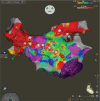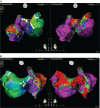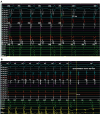Breaking the Circuit: A Case of Macro-re-entrant Biatrial Tachycardia
- PMID: 40919529
- PMCID: PMC12410503
- DOI: 10.19102/icrm.2025.16082
Breaking the Circuit: A Case of Macro-re-entrant Biatrial Tachycardia
Abstract
We present a case of a 71-year-old woman with symptomatic paroxysmal atrial fibrillation and atypical atrial flutter (AFL), ultimately diagnosed with a rare type 3 macro-re-entrant biatrial tachycardia (BiAT). Despite initial pulmonary vein isolation and anterior line ablation for atypical AFL, she experienced recurrent AFL requiring a complex redo ablation. Successful termination of the tachycardia was achieved by extending ablation to the septal regions of both atria. This case highlights the complexity of managing BiAT.
Keywords: Atrial fibrillation; atypical atrial flutter; catheter ablation; macro–re-entrant biatrial tachycardia.
Copyright: © 2025 Innovations in Cardiac Rhythm Management.
Conflict of interest statement
The authors report no conflicts of interest for the published content. No funding information was provided.
Figures







References
Publication types
LinkOut - more resources
Full Text Sources
